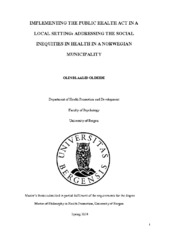Implementing the Public Health Act in a local setting: Addressing the social inequities in health in a Norwegian municipality
| dc.contributor.author | Oldeide, Olin Blaalid | |
| dc.date.accessioned | 2014-07-23T10:57:32Z | |
| dc.date.available | 2014-07-23T10:57:32Z | |
| dc.date.issued | 2014-05-20 | eng |
| dc.date.submitted | 2014-05-20 | eng |
| dc.identifier.uri | https://hdl.handle.net/1956/8218 | |
| dc.description.abstract | Background: The increasing presence of social inequities in health defies the values of solidarity and justice. In an attempt to address this challenge The Public Health Act was adopted 2012 in Norway. The Act proposes to reduce the social inequities in health through a Health in All Policies approach, which reflects that health is to be promoted through the contribution of all societal and political sectors. The Act reflects the need for a comprehensive health promotion profile in the municipalities, as the conditions affecting peoples' everyday lives are strongly influenced by the municipality through public policies and services. Therefore this study seeks to investigate how the municipalities are implementing the Public Health Act, with particular focus on how they are addressing the SIH. Objectives: The main objective is to gain insight into how the municipality is addressing the responsibilities proposed by the Public Health Act, with particular focus on the SIH. To fulfil the objectives of this study, the following research questions are presented: RQ 1: What policies are in place at the municipal level concerning health promotion and SIH? RQ 2: Do the plans and interventions at the municipal level include the HiAP approach and intersectoral collaboration? RQ 3: Which efforts are taken at a municipal level to reduce SIH? RQ 4: What challenging- and success factors does the municipality experience associated with implementing the Public Health Act, with special considerations connected to SIH? Theoretical framework: The theoretical framework for this study is compiled of literature connected to health equity and the Social Determinants of Health model. Methods: The study takes form as a case study. The data was collected through qualitative face to face interviews with the political and administrative leadership in one municipality and a document analysis of the municipal plans. Results and discussion: The findings from the municipality illustrates that the social determinants view is implicitly represented there. This implicit understanding is discussed in relation to the political history of the municipality. The efforts connected to addressing SIH can be characterized as proportionate universalism. There is on the other hand little evidence of successful HiAP approach in the municipality. The surrounding structures of the municipal organization may be limiting the progress of health promoting policies at a local level. In conclusion the municipality adheres to some of the principles of the Public Health Act. Conclusions: The notion that health promoting principles have grown from within the organization and are now reinforced from a national angle may bode well for the future of health promotion within the municipality. An important lesson to learn is to build on the existing structures of health promotion principles and further encourage the principle of HiAP to more effectively address SIH in local governments. | en_US |
| dc.format.extent | 1227307 bytes | eng |
| dc.format.mimetype | application/pdf | eng |
| dc.language.iso | eng | eng |
| dc.publisher | The University of Bergen | eng |
| dc.subject | Social Inequities in Health | eng |
| dc.subject | Health in All Policies | eng |
| dc.subject | Local goverment | eng |
| dc.subject | Social determinants of health | eng |
| dc.title | Implementing the Public Health Act in a local setting: Addressing the social inequities in health in a Norwegian municipality | eng |
| dc.type | Master thesis | |
| dc.rights.holder | Copyright the author. All rights reserved | |
| dc.description.degree | Master of Philosophy in Health Promotion | |
| dc.description.localcode | HEPRO350 | |
| dc.description.localcode | MPHEPRO | |
| dc.subject.nus | 769909 | eng |
| fs.subjectcode | HEPRO350 |
